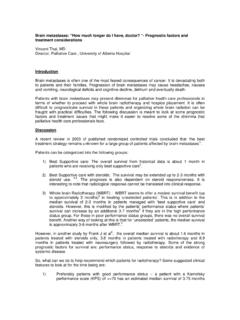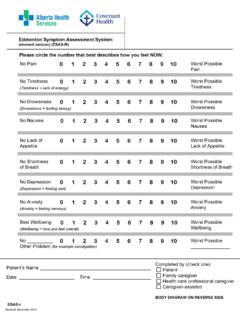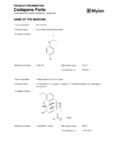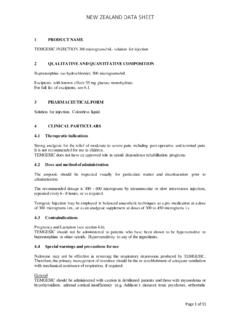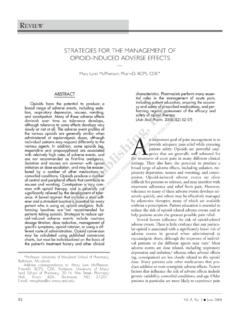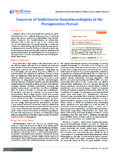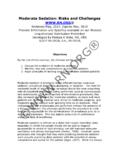Transcription of 3A11 Bowel Care Protocol for Constipation final
1 K:\Administration - RPCP\RPC Program Binder\SECTION 3 CLINICAL\3A Guidelines\ 3A11 Bowel care Protocol for Constipation 1 Protocol Edmonton Zone Palliative care Program Title: Bowel care Protocol for Managing Constipation in Palliative care patients Date Approved: Developed March 2003; Revised August 2011 Approved By: Practice, Development, and Quality Committee Author J. Tycholiz BScN; Contributing Author S. Watanabe MD General information: Constipation is defined as infrequent, incomplete or difficult evacuation of the bowels and is subjectively defined in comparison to what is normal for that individual; it is not based solely on the frequency of stool. Constipation is a common cause of morbidity in palliative care patients and can severely compromise quality of life. Palliative care patients are at greater risk of Constipation because of an increased number of combined factors and not only as a result of opioid usage.
2 Purpose: This document is intended to provide practitioners with information to assess and manage Constipation in palliative care patients across various settings. The information provided must be applied to each patient in context with their disease status and based on appropriate assessment in line with the disease process. A. Common causes of Constipation in palliative care Poor appetite, low oral intake of fiber and fluids Lack of privacy, cultural sensitivities, inability to toilet independently, delayed defecation Advanced age, decreased mobility, depression, sedation Pharmacological agents such as opioids, anticholinergics, 5-HT3 antagonists, antidepressants, antiepileptics, oral iron supplements, antacids Metabolic disturbances such as dehydration ( secondary to fever, vomiting, polyuria, poor fluid intake, diuretics), hypercalcemia, renal failure hypokalemia, hypothyroidism, diabetes Neurological disorders, as with cerebral tumors, spinal cord involvement, sacral nerve infiltration, autonomic failure (primary as in Parkinson s disease, multiple sclerosis, motor neuron disease, or secondary as in cancer, diabetes) K.
3 \Administration - RPCP\RPC Program Binder\SECTION 3 CLINICAL\3A Guidelines\ 3A11 Bowel care Protocol for Constipation 2 Structural abnormalities (pelvic tumor mass, radiation fibrosis, painful anorectal conditions/ hemorrhoids, fissures, perianal abscess) B. Complications of Constipation Abdominal pain, distension, discomfort Nausea, vomiting, anorexia and dehydration Overflow diarrhea Hemorrhoids, anal fissures Bowel obstruction Urinary retention Increased need for medication Anxiety and restlessness Decreased quality of life, increase in patient and family distress Increase in health care visits, increased health care costs C. Assessment Considerations when assessing Constipation : History of Bowel movements correlates poorly with actual amount of stool detected radiologically. Therefore, abdominal x-ray is recommended when available; a Constipation score of 7/12 or higher with associated symptoms constitutes urgent treatment.
4 A thorough history and physical examination includes the following elements: Patient s normal Bowel pattern prior to illness Current stool characteristics, volume, consistency, colour, odour, blood Patient s perception of the ease/difficulty (straining) of passing stool Sense of complete evacuation Frequency of stools per day/week Any psychosocial factors that may be inhibiting defecation Compliance with/intolerance to Bowel medication Review of medications prescribed, over-the-counter and natural products/ reassess unnecessary medications that may be contributing to Constipation Alert: Rule out Bowel obstruction! Clinical signs and symptoms of Bowel obstruction may include constant cramping/colicky pain, distended/bloated abdomen, nausea/ vomiting (varies in intensity based on the level of obstruction and degree of compromise of Bowel patency), and high pitched/absent Bowel sounds. If suspected, obtain three views of the abdomen and observe for dilated gas-filled Bowel , air-fluid levels, and absence of gas and stool in the distal Bowel .
5 K:\Administration - RPCP\RPC Program Binder\SECTION 3 CLINICAL\3A Guidelines\ 3A11 Bowel care Protocol for Constipation 3 Assessment of symptoms such as lack of appetite, early satiety, nausea, bloating, distension, passing flatus, pain, colic, tenesmus Digital rectal examination (DRE) if no BM for 3 days, if not contraindicated (neutropenia, painful conditions, risk for bleeding); assess for anal sphincter tone, presence/absence of stool, possible obstructing masses, hemorrhoids, anal fissures, dilated rectum (may indicate Constipation higher in sigmoid area) Special considerations for assessment and treatment for patients with rectal stent, colostomy, ileostomy Determining if diarrhea is overflow diarrhea; rule out other etiologies for true diarrhea Goal of treatment: Assist patient in having adequate and timely comfortable Bowel movements using methods that are compatible with patients overall performance status and preference.
6 D. Management 1. Oral Pharmacological Approaches Laxatives are the primary pharmacological intervention for treating Constipation , despite lack of empirical evidence in palliative care . To date, the best evidence supports the use of osmotic laxatives such as lactulose and polyethylene glycol (PEG). However, expert consensus recommends that choice of treatment should be based on patient preference and overall condition, with consideration of disease trajectory. Historically, a combination of stool softeners and stimulants were employed simultaneously for Constipation management and prophylactically for prevention of Constipation when opioids were initiated. Currently, senna-based stimulants and bisacodyl are utilized despite lack of evidence of efficacy. Initiation of docusate is not recommended; however, if the patient has been utilizing this medication and feels that it is beneficial, then there is no need to discontinue it. Titration of laxatives is based on quality of stool (constipated/loose, overall volume) and ease/difficulty of passing stool.
7 Laxatives are categorized into four classes: a) osmotic agents, b) stool softeners, c) stimulants and d) bulking agents. a. Osmotic laxatives: Work by attracting and retaining fluid into the Bowel to form softer stool. Onset of action is 24-48 hours. Latency of actions is 1-2 days and up to 3 days. Examples: PEG 3350, lactulose, magnesium citrate (magnesium citrate is not used prophylactically but when a more aggressive Bowel cleansing is required). PEG 3350 contains no electrolytes and it may be preferred over agents with non-absorbable sugars as these agents are associated with increased gas production, cramping and abdominal distension. PEG 3350 is tasteless and has low toxicity. Saline osmotic laxatives and magnesium citrate can produce undesirably strong purgative actions. Dehydration may occur with repeated use of saline laxatives. K:\Administration - RPCP\RPC Program Binder\SECTION 3 CLINICAL\3A Guidelines\ 3A11 Bowel care Protocol for Constipation 4 They have a limited role in long-term management of Constipation in cancer patients due to the potential for adverse effects in this population.
8 Usual dosage: Lactulose 15-30 ml daily to tid PEG 3350 17 g daily to 75 g daily (may be given in divided doses) b. Stool softeners (emollient laxatives): Increase the wetting efficiency of intestinal fluid and facilitate the mixing of aqueous and fatty substances that soften feces. They do not stimulate peristalsis and therefore can be utilized in a subacute Bowel obstruction. Onset of action is 24-72 hours. Latency of action is 1-3 days. Examples: docusate calcium, docusate sodium, mineral oil Usual dosage: Docusate sodium (Colace) 100-200 mg or docusate calcium 240-480 mg bid to start, and then increase to tid or qid c. Peristaltic stimulants: Help to induce peristalsis. Side effects include colic. Stimulants can increase the severity of colic with a Bowel obstruction. Onset of action is ~12 hours. Latency of action is 6-12 hours. Examples: senna, bisacodyl. Bisacodyl is available as a tablet or suppository; it may be beneficial in cases of refractory Constipation and in the management of cancer patients with colostomies who have managed them with routine irrigation but now find it difficult to perform this procedure.
9 Usual dosage: Sennosides mg (Senokot) or 12 mg (Glysennid) at hs to start then titrate up to 2-4 tabs bid to qid Bisacodyl 5-15 mg daily d. Bulking agents/fiber: Increase stool size and promote peristalsis. Onset is 10-24 hours. Examples: psyllium, methylcellulose, bran, aloe vera. However, not recommended (see below ). Alert: It is unrealistic for most palliative care patients to be able to consume sufficient fiber for increasing peristalsis or enough fluids for safe use of dietary fiber supplements ( liters of fluid per day). Encouraging increased fiber is not supported in palliative care practice. 2. Rectal Interventions ALERT: Avoid Digital Rectal Examination (DRE) in neutropenic patients Suppository for stimulation or softening determined by DRE Hard feces at anus Give stool softener glycerin suppository Soft stool poor anal tone Give stimulant bisacodyl suppository K:\Administration - RPCP\RPC Program Binder\SECTION 3 CLINICAL\3A Guidelines\ 3A11 Bowel care Protocol for Constipation 5 Hard stool throughout the lower rectum Give stool softener glycerin suppository, followed by stimulant bisacodyl suppository (bisacodyl suppository needs to be in contact with the Bowel wall).
10 Normal stool Give stimulant bisacodyl suppository Alert: If patient requires digital disimpaction, obtain consent from patient or family and provide sufficient analgesia or sedation. 3. Specific management of opioid-induced Constipation Constipation has been reported as ranging from 50-95%, with the highest incidence observed in patients receiving opioids. Prophylactic use of laxatives is required at the time of initiating opioids. Typical laxative regime when starting opioids to prevent Constipation Docusate sodium 100 mg or docusate calcium 240 mg 1-2 bid Senokot 2 qhs Titrate above laxatives based on stool consistency and frequency If no BM every 3 days, then give suppository based on stool consistency If suppository unsuccessful, give Fleet enema or Microenema If still no BM, give high mineral oil retention enema; after at least 4 to 6 hours, follow with a soap suds enema Role of methylnaltrexone in the management of opioid-induced Constipation Methylnaltrexone (Relistor) is a peripherally-acting opioid antagonist which blocks opioid receptors at GI tract level without reversing analgesia In one study, laxation was noted within 4 hours of drug administration in 48% of patients Primarily used for acute management of opioid-induced Constipation when oral or rectal interventions are ineffective and/or maintenance therapy of opioid-induced Constipation when oral laxatives are ineffective Consider cost Prepare patient that Bowel movement may occur rapidly following medication administration Usual dosage: 8 kg-62 kg (84 lbs-136 lbs) 8 mg sc; 62 kg-114 kg (136-251 lbs) 12 mg sc; administer every 2 days.
